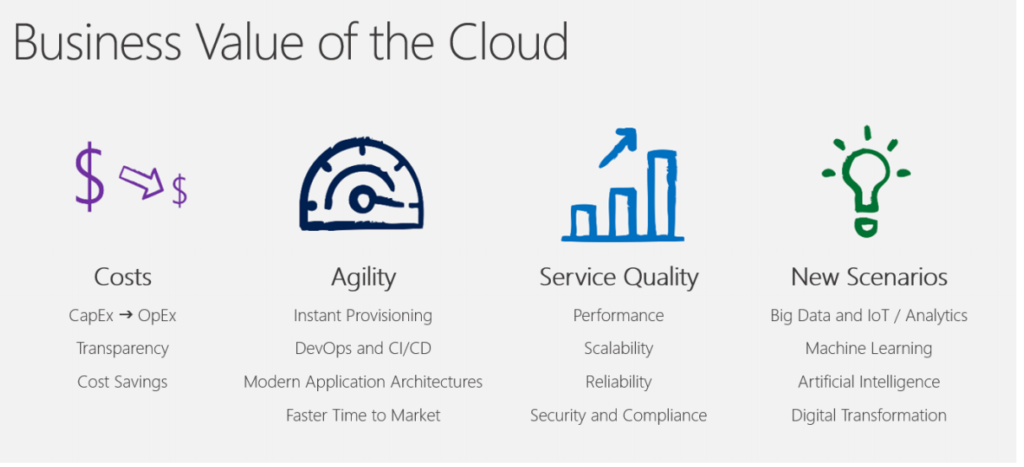
To succeed in a digital-first world, business leaders are bringing business and IT closer together and optimising processes to create new value for customers. Cloud technologies are an enabler to help connect people, data, and processes in new ways to embrace the possibilities enabled by modern technologies.
The potential is huge. By 2019, IDC predicts $1.7 trillion USD in spending worldwide to create new business models, operational efficiencies, and customer experiences. Digital transformation is now an executive mandate.
The Cloud Enables Digital Transformation
Cloud technologies are at the centre of the digital transformation revolution. The cloud has changed more than the way we implement and manage IT; it’s changing the very fabric of business. With ready access to data, and intelligent new ways to view, analyse and use the information, the cloud has engendered powerful new capabilities which are disrupting entire business models. There are many advantages to adopting the cloud. Businesses moving to the cloud do so for a range of motivations, seeking a variety of benefits. These benefits fall into four categories: cost, agility, service quality, and new scenarios:
Cost: Cloud computing offers significant potential cost-savings over on-premises infrastructure, especially considering the full cost of the latter. In addition, cloud computing enables organizations to move IT spending from capital expenditure (CapEx) to operational expenditure (OpEx). Since the fixed costs associated with shared infrastructure are avoided, the cloud also provides much greater visibility into the true cost of individual applications.
Agility: Where traditional on-premises infrastructure can take weeks or even months to deploy, Azure offers near-instant provisioning of resources. This enables Azure projects to move much more quickly, without the need to over-provision resources in advance or spend considerable time on infrastructure planning. To take full advantage of this new flexibility, organizations are accelerating the adoption of new ways of working, such as by using agile software development methodologies, continuous integration and deployment (CI/CD), and modern PaaS-based application architectures.
Service quality: Azure’s infrastructure has been designed to support some of the world’s most demanding workloads. These workloads continuously raise the bar on the quality of service Azure must provide. As a result, migration to Azure often offers significant improvements in performance, reliability, and security over on-premises infrastructure.
New scenarios: Azure enables new application scenarios which are simply not possible, or would be prohibitively expensive to deliver, using on-premises infrastructure, such as big data storage and analytics, machine learning, and compliance with industry certifications such as ISO, PCI, HIPA and GDPR, where customers can leverage the certifications offered by cloud providers. These technologies are enabling new application scenarios, driving innovation and competitive advantages only available in the cloud.

These benefits are all central to a successful digital transformation strategy.
Reduced costs and the shift from CapEx to OpEx dramatically lowers the cost of innovation, enabling a ‘failfast’ experimental approach. This is supported by the increase in agility that lowers innovation cost and enables a faster time-to-market.
The scale, performance, reliability, and global reach of the cloud enables small development teams to develop global services for global audiences. Most of all, new technologies including big data, IoT, machine learning, and AI empower the insight and customer focus upon which digital transformation depends. These technologies are often only available in the cloud or are prohibitively expensive on-premises. Moreover, competition between major cloud providers is driving a tidal wave of innovation within the cloud itself.
New features and services are added on a weekly or even daily basis, providing an ever-richer platform and enabling business to continue to experiment, innovate, reduce cost and deliver increasing value. Embracing the cloud is not simply the easiest, or cheapest, or fastest way to drive digital transformation—it is the only way. For many businesses, the first step on this journey is to migrate existing applications to the cloud.
Migrating your core applications to the cloud represents an enormous business opportunity.
As businesses of all sizes embrace digital transformation, traditional on-premises IT becomes increasingly seen as a costly, restrictive, and distracting burden. This creates pressure to reduce or even eliminate on-premises IT by moving existing applications and services to the cloud. The business-critical nature of many existing applications means any change—especially one as fundamental and far-reaching as cloud migration—represents a business risk. Migration must be as seamless and safe as possible.
Cloud migration is a highly technical endeavour and requires skills and experience that are lacking in traditional IT departments. Recognising this, many businesses seek outside expertise to help them with their cloud migration journey.
Once moved to the cloud, applications must be maintained and updated, and many businesses will outsource this ongoing maintenance to specialist managed service providers, like Microsoft Gold Partner, INNOVATE – The IT Solutions People.
Outsourcing this work also enables a business to focus on their core activities rather than IT.




